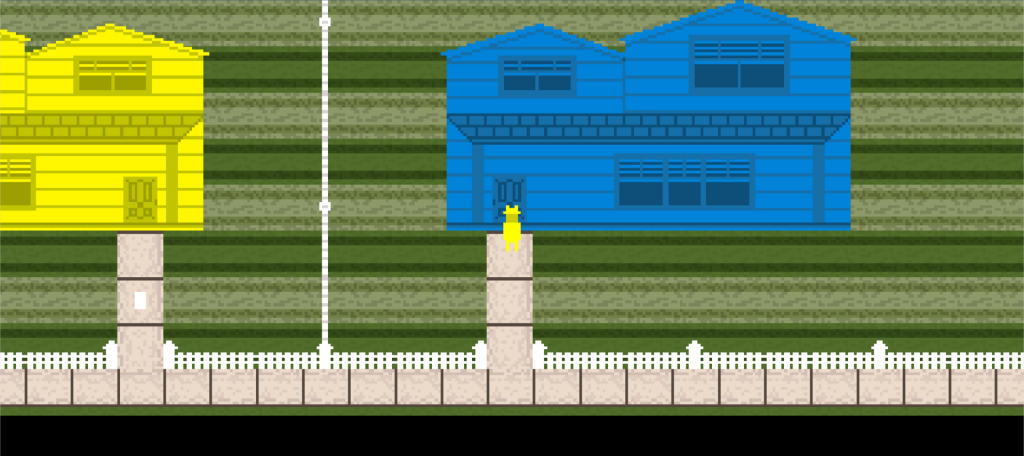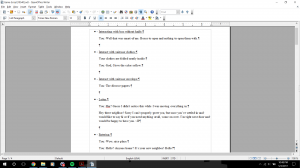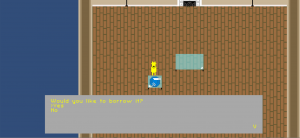 As of the second State of the Game session, “Borrowing” is behind where I want it to be but still acceptable for what can be done in a single semester. There were no major advances or setbacks, but managing other schoolwork while attempting to figure out C# code has been difficult. My main source of difficulty has been constructing the borrowing system, that is, being able to interact with an object in the blue house, display a dialogue box with text and an option, use the player’s option to either leave alone or remove the object that was interacted with, and then being able to put it back down in a corresponding place in the yellow house after another interaction and small set of dialogue boxes. This should be very simple in principle, but getting my head around Unity terminology though C#, neither of which I’m familiar with, has proven very difficult.
As of the second State of the Game session, “Borrowing” is behind where I want it to be but still acceptable for what can be done in a single semester. There were no major advances or setbacks, but managing other schoolwork while attempting to figure out C# code has been difficult. My main source of difficulty has been constructing the borrowing system, that is, being able to interact with an object in the blue house, display a dialogue box with text and an option, use the player’s option to either leave alone or remove the object that was interacted with, and then being able to put it back down in a corresponding place in the yellow house after another interaction and small set of dialogue boxes. This should be very simple in principle, but getting my head around Unity terminology though C#, neither of which I’m familiar with, has proven very difficult.
There’s a good amount that’s keeping me interested in the project, however. The end is in sight as far as laying down the main mechanic into the game goes, and having that done would be a huge milestone in the overall development of the game. I also found myself reinvigorated by the comments and suggestions made during the second paper game playthrough, but more on that later. Finally, it just so happened that I came across a free indie game called Packing Up the Rest of Your Stuff on the Last Day at Your Old Apartment that really inspired me. It’s a short first-person game where you do as the title says: pack up your things. As you interact with your junk, a sentence or two pops up where you reminisce about the object. There’s a bit of inventory management involved while packing since each object takes up a certain amount of space and not everything in your room can fit in your boxes; you have to decide what to keep and what to junk. It was a nice little bittersweet piece that I enjoyed the atmosphere of – a mix of hopeful nostalgia and melancholy – and that’s something I hope to get across in “Borrowing”, though, of course, in the latter you’re unpacking and there’s (hopefully) a much more foreboding ambiance.
I didn’t have any questions going into the second State of the Game; I felt that what I had concerns about (mostly mechanical tidbits that were addressed in my previous post) had been addressed, and I wasn’t too surprised that the players were interested in wanting a bit more detail in the environment, especially the outdoor area, and text boxes because the game as it stood was very straightforward and there was not much room for critique. Changes after the second State of the Game are not incredibly substantial. I’m interested in seeing if I can play around with dialogue text color and perhaps tinting of rooms.
The battle between calculation and choice/conflict is an interesting one when it comes to “Borrowing”. In some sense, the game is entirely about choice (choosing whether or not to steal the objects in the blue house and then choosing whether or not to open the boxes in the yellow house) and one hopefully feels conflicted when being presented with these choices. It’s difficult for me to say where player calculation comes into play unless it’s the calculated decision that the game isn’t worth his or her time anymore.
Ideally, all three maps – the yellow house, the blue house, and the street – have either conflict, choice, or both. The player must be both faced with choice and conflict in the blue house (again, the stealing is ideally both a choice the player finds they do not necessarily have to make as well as something of a moral conflict (or maybe they have fun with it and this is something of a critique that can be made, hmm…)); conflict must be faced in the yellow house (the Twilight Zone sense of unease is something that I’m going for in this case; the idea that anything can be in the boxes and anything can happen to the objects that are pulled out of the boxes, ideally to mess with the player and make them nervous to open the next one or wary of what might happen next was something that really struck home during the second paper game session); and conflict is something that I would absolutely like to present in the street (a car that follows you, a single person who walks up and asks what you’re doing, etc. would be a great way of presenting player conflict and heightening the dread or paranoia that comes with the acts you perform).



